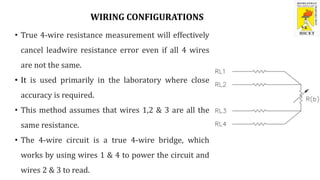RTD.ppt
- 1. HINDUSTHAN COLLEGE OF ENGINEERING & TECHNOLOGY RESISTANCE TEMPERATURE DETECTOR Department of Biomedical Engineering
- 2. INTRODUCTION • A Resistance Temperature Detector (also known as a Resistance Thermometer or RTD) is an electronic device used to determine the temperature by measuring the resistance of an electrical wire. • This wire is referred to as a temperature sensor. • If we want to measure temperature with high accuracy, an RTD is the ideal solution, as it has good linear characteristics over a wide range of temperatures. • The resistance increases as the temperature of the sensor increases.
- 3. INTRODUCTION • The resistance vs temperature relationship is well known and is repeatable over time. • An RTD is a passive device. • It does not produce an output on its own. • External electronic devices are used to measure the resistance of the sensor by passing a small electrical current through the sensor to generate a voltage. • The variation of resistance of the metal with the variation of the temperature is given as,
- 4. INTRODUCTION • The variation of resistance of the metal with the variation of the temperature is given as, Where, Rt and R0 are the resistance values at toC and t0 oC temperatures. α and β are the constants depends on the metals.
- 5. WORKING • In RTD devices; Copper, Nickel and Platinum are widely used metals. • These three metals are having different resistance variations with respective to the temperature variations. • That is called resistance-temperature characteristics.
- 6. CONSTRUCTION
- 7. TYPES OF RTD • In Wire-wound RTD uses platinum wire wound around a ceramic or glass bobbin. • The construction keeps the platinum wire loose and lets it expand and contract freely with a change in temperature. • This minimizes long-term stress-induced resistance change, but has very poor resistance to vibration and is primarily limited to lab use.
- 8. TYPES OF RTD • In Thin Film, the bifilar winding is wound around the bobbin and then sealed with molten glass, ceramic cement, or another high-temperature, non-conductive coating. • This construction helps protect the wire from vibration, but it is prone to long-term stress induced resistance change when the bobbin and platinum wire have different temperature coefficients of expansion.
- 9. WIRING CONFIGURATIONS • A 2-wire configuration is the simplest but the least accurate configuration. • This constructions result in leadwire resistance getting added to the element resistance. • 2-wire RTD’s are mostly used with short lead wires or where close accuracy is not required.
- 10. WIRING CONFIGURATIONS • 3-wire construction is most commonly used in industrial applications where the third wire provides a method for removing the average lead wire resistance from the sensor measurement. • It works by measuring the resistance between #1 & #2 (R 1+2) and subtracting the resistance between #2 & #3 (R 2+3) which leaves just the resistance of the RTD bulb (R b). • This method assumes that wires 1,2 & 3 are all the same resistance.
- 11. WIRING CONFIGURATIONS • True 4-wire resistance measurement will effectively cancel leadwire resistance error even if all 4 wires are not the same. • It is used primarily in the laboratory where close accuracy is required. • This method assumes that wires 1,2 & 3 are all the same resistance. • The 4-wire circuit is a true 4-wire bridge, which works by using wires 1 & 4 to power the circuit and wires 2 & 3 to read.










